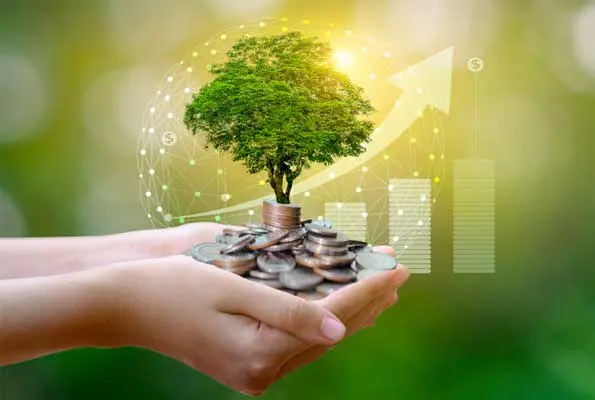If the GCC adopts a ‘green growth strategy’, its GDP might exceed USD 13 trillion by 2050, according to the World Bank. With a 10% annual growth rate, Abu Dhabi is leading the way.
According to the Statistics Centre-Abu Dhabi (SCAD), Abu Dhabi’s GDP grew 10.5% annually in the first nine months of 2022 compared to 2021, making it MENA’s fastest-growing economy. Real estate, lodging, food services, wholesale, and retail commerce drove 10.3% annualised non-oil GDP growth in the third quarter of 2022.
Abu Dhabi is transforming into a knowledge-based and diversified economy while changing its regulatory and legislative structures to attract foreign direct investment in non-oil sectors.
The country aims to be a “green falcon economy,” combining rapid economic growth driven by innovation, change, and diversification across major economic sectors with a strong focus on sustainability.
World-First Economic Ventures
UAE’s attempts to promote ‘green economic growth’ are centred in Abu Dhabi, with 1.56 million people and a GDP of up to USD 300 billion in 2022.
Abu Dhabi Global Market (ADGM) has developed a sustainable finance framework, strengthened its ESG policies, encouraged green investment, helped incubate green tech start-ups, and become the world’s first “carbon neutral” international financial centre by offsetting carbon emissions.
It proposes to build the world’s first fully regulated carbon trading exchange and clearing house with AirCarbon Exchange, a Singapore-based global carbon exchange employing distributed ledger technology in a traditional trading architecture.
UAE financial regulators, federal ministries, and exchanges form the Sustainable Finance Working Group (SFWG), chaired by ADGM. ADGM’s Financial Services Regulatory Authority (FSRA) encourages UAE regulatory cooperation on sustainable finance practises and standards.
Cop28 will be held at Expo City Dubai in November 2023. In 2023, the ‘global stocktake’ will review countries’ progress toward the Paris Agreement’s 2016 goals.
“There is an ever-growing synergy between economic growth and sustainability,” World Bank country director of the Gulf Cooperation Council, Middle East, and North Africa Issam Abousleiman said at ADGM’s Abu Dhabi Sustainable Finance Forum in January 2023.
“Sustainability is not costly. The World Bank found no long-term trade-off between carbon reduction, economic growth, and poverty reduction,” the official stated further.
Countries in the Gulf region are poised to benefit from the clean energy transition because the region already has a record-breaking, low-cost solar energy auction in the UAE, Saudi Arabia, and Qatar. It costs about a penny per kilowatt.
The region might lead to green and blue hydrogen production. Their transformation may be supported by rules, policies, and investment to create stronger, more sustainable economies that create good employment and safeguard the environment.
“This is in line with GCC countries’ visions of the future economy, which relies increasingly on the private sector for investment, job creation, and value addition. All country vision statements emphasise technology innovation, climate change, and diversification,” Issam Abousleiman stated further.
A Green Growing System
Abousleiman said the GCC region—Bahrain, Kuwait, Oman, Qatar, Saudi Arabia, and the UAE—had a USD 2 trillion GDP in 2022 and is expected to reach USD 6 trillion by 2050 on a business-as-usual basis. Using a green growth approach might boost the economy to around USD 13 trillion by the same year.
With a green growth plan and a 1% productivity gain, that is true. Abousleiman projected that this technique might boost growth by 5% per year until 2050.
The UAE aims for net zero by 2050. Abu Dhabi has 79% of the Middle East’s solar photovoltaic (PV) capacity and is a leader in sustainable energy.
By 2025, solar PV will generate 7% of Abu Dhabi’s electricity and nuclear 39%. It plans to install 8.2 GW of clean and renewable energy capacity by then. It also offers clean energy certificates to help businesses clean up and invest in green energy.
The government has unveiled a hydrogen policy and regulatory framework to advance Abu Dhabi’s hydrogen ambition and lead the world in low-carbon, clean hydrogen. By 2030, it might produce over one million tons of low-carbon hydrogen.
Due to its industrial capability across the energy value chain, excellent infrastructure, experience exporting volatile chemicals, and central location between large-demand markets, the Emirates is a leading hydrogen production base. It also has strong finances and a flexible foreign investment regulatory framework.
Collaborative Efforts
Dr. Sultan Al Jaber, president of Cop28, UAE minister of industry and advanced technology, and special envoy for climate change told delegates at the Atlantic Council’s Global Energy Forum in January, “Let me extend an open invitation to all parties across government, private sector, and civil society: cooperate, collaborate, share your ideas, and talk to us.”
“We can only succeed with open, constructive dialogue. Together, we can transform the paradigm for real progress. Remember that reaching net-zero emissions would revolutionise markets and offer the greatest economic and human potential since the first industrial revolution,” the official remarked further.
Abu Dhabi wants to show the Middle East and the world how to combine rapid economic growth with a greener economy by driving such dialogue.



